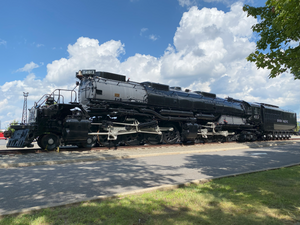Preserved American 4-8-8-4 locomotive
| Union Pacific 4012 |
|---|
 |
|
| Specifications |
|---|
Configuration:
| |
|---|
| • Whyte | 4-8-8-4 |
|---|
| • UIC | (2′D)D2′ h4 |
|---|
| Gauge | 4 ft 8+1⁄2 in (1,435 mm) |
|---|
| Leading dia. | 36 in (914 mm) |
|---|
| Driver dia. | 68 inches (170 cm) |
|---|
| Trailing dia. | 42 in (1,067 mm) |
|---|
| Minimum curve | 288 ft (88 m) radius/ 20° |
|---|
| Wheelbase | - Locomotive: 72 ft 5.5 in (22.09 m)
- Overall: 117 ft 7 in (35.84 m)
|
|---|
| Length | - Locomotive: 85 ft 7.8 in (26.11 m)
- Overall: 132 ft 9+7⁄8 in (40.48 m)
|
|---|
| Width | 11 ft (3.4 m) |
|---|
| Height | 16 ft 2+1⁄2 in (4.94 m) |
|---|
| Axle load | 67,500 lb (30,617 kilograms) |
|---|
| Adhesive weight | 540,000 lb (244,940 kilograms) |
|---|
| Loco weight | 762,000 lb (345,637 kilograms) |
|---|
| Tender weight | 342,200 lb (155,219 kilograms) (2/3 load) |
|---|
| Total weight | 1,250,000 lb (566,990 kilograms) |
|---|
| Tender type | 25-C |
|---|
| Fuel type | Coal |
|---|
| Water cap. | 24,000 US gal (91,000 L; 20,000 imp gal) |
|---|
| Firebox: | |
|---|
| • Grate area | 150 sq ft (14 m2) |
|---|
| Boiler | 95 in (2,400 mm) |
|---|
| Boiler pressure | 300 lbf/in2 (2.1 MPa) |
|---|
| Heating surface: | |
|---|
| • Firebox | 704 sq ft (65 m2) |
|---|
| • Tubes and flues | 5,185 sq ft (482 m2) |
|---|
| • Total surface | 5,889 sq ft (547 m2) |
|---|
Superheater:
| |
|---|
| • Type | Type E |
|---|
| • Heating area | 2,466 sq ft (229 m2) |
|---|
| Cylinders | 4 |
|---|
| Cylinder size | 23.75 in × 32 in (603 mm × 813 mm) |
|---|
|
| Performance figures |
|---|
| Maximum speed | 80 mph (130 km/h) |
|---|
| Power output | 5,300–7,000 hp (4,000–5,200 kW) @ 41 mph |
|---|
| Tractive effort | 135,375 lbf (602.18 kN) |
|---|
| Factor of adh. | 3.99 |
|---|
|
|
Union Pacific 4012 is a 4884-1 class 4-8-8-4 "Big Boy" type steam locomotive, one of eight preserved Union Pacific Big Boy locomotives. Built in November 1941 by the American Locomotive Company (ALCO) at its Schenectady Locomotive Works of Schenectady, New York, No. 4012 was retired in 1962 and donated to Steamtown, U.S.A, in Bellows Falls, Vermont, and later moved to Steamtown National Historic Site in Scranton, Pennsylvania, where it remains today.

